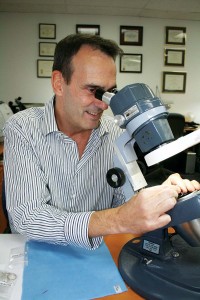A matter of opinion

In an industry where trust is paramount, news of a grading scandal tends to shake even the most cynical. One earlier this year at HRD Antwerp, complete with allegations of inappropriate conduct involving four diamond graders and three unnamed companies, sparked intense outcry, with many calling for the firms to be identified. The incident is an extreme example of how grading can be manipulated, but it reignited debate surrounding acceptable grade differences.
As Jewellery Business contributor Mark T. Cartwright pointed out in his August column, a variance of a single grade rarely makes a difference in price. It is also not unusual for labs to differ in opinions even though they are all using the Gemological Institute of America’s (GIA’s) grading system. As Cartwright puts it, they are all speaking the same language, but using different dictionaries.
“Grading is subjective,” says Barbuzzi, pointing out that no two of the six sets of GIA master colour stones in the Texas office are alike. “If I take a diamond that was graded by GIA in California and take the same diamond to GIA’s office in Mumbai, I may get a difference of opinion. Who’s right and who’s wrong? Neither. They’re both right, because it is all a matter of opinion and you’re allowed a certain leeway on either side.”
Tatarsky says most labs—GSL included—strive for consistency among their graders, and that smaller offices like theirs might be better able to meet that goal. Bigger labs, however, can have upward of 200 graders; getting everyone to grade the same way can be challenging.
“There are times when I think our offices have better consistency than other major labs only because we have fewer people to actually tighten into the way we grade diamonds,” he explains.
For the most part, however, Tatarsky says retailers and diamond wholesalers get a sense over time how a particular lab will grade a diamond. Still, market reality dictates that grades naturally evolve; what used to be an SI2 say, 20 years ago is not an SI2 today. Staying aware of grading trends is paramount.
“I don’t want to be grading diamonds today the same way I did 30 years ago if GIA isn’t,” Barbuzzi says. “I have to keep up with the way GIA is doing it. It reinforces what I do. If there is a difference of one grade, that’s allowable. If it’s two, three, or four, then we have a problem. And we’ve never had a problem.”
Every three months, GSL’s biggest U.S. client randomly selects stones the lab has graded and sends them to GIA. Barbuzzi says it’s a method of quality control he welcomes, as it helps ensure GSL’s gradings remain in line with the rest of the industry. He also likes to do his own homework. Leaving his loupe at home, he regularly drops by local retailers to check out what their prices are like, and compares the grading reports to the merchandise.
“I have to know what my customer’s competition is doing,” he says, adding he asks to use a magnifier rather than a loupe to not alert staff to his background. He says that for the most part, what he sees and what is on the report match up.
Overall, most jewellers understand that legitimate grading variations are the norm, given the subjective nature of the process. Some equipment exists that can determine colour grade, although it cannot properly read stones in the I, J, K, and L range. But what if technology existed one day that could consistently grade all four Cs. Would labs become obsolete?
“Well, you’d still need someone to work the machines,” Barbuzzi says.





